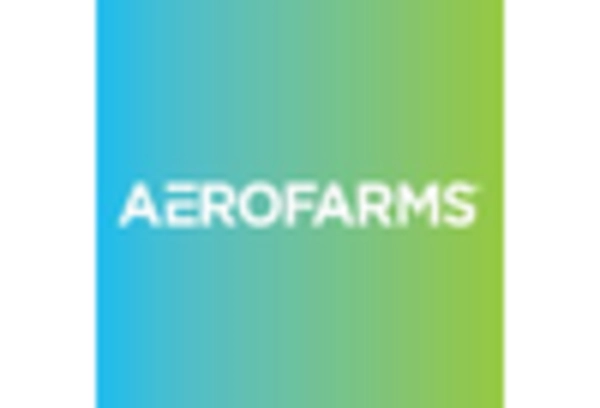Increased Focus on Local Sourcing
The microgreens Market is witnessing a significant trend towards local sourcing, as consumers become more aware of the environmental impact of food transportation. This shift is encouraging the growth of local farms and urban agriculture initiatives, which are increasingly supplying fresh microgreens to nearby markets and restaurants. The microgreens Market Industry is benefiting from this trend, as local sourcing not only reduces carbon footprints but also ensures fresher produce for consumers. According to recent data, local food sales in the US have surged, with a reported increase of 15% in the last year alone. This trend aligns with the growing consumer preference for supporting local economies and sustainable practices. As more consumers seek out locally sourced microgreens, the market is likely to expand, providing opportunities for small-scale farmers and enhancing the overall appeal of the microgreens Market.
Innovations in Hydroponic Farming
Technological advancements in hydroponic farming are significantly impacting the microgreens Market. Hydroponics allows for year-round cultivation of microgreens, independent of seasonal constraints, which is particularly advantageous in regions with harsh climates. The microgreens Market Industry is seeing an increase in hydroponic farms, which can produce higher yields in smaller spaces. This method not only conserves water but also minimizes the use of pesticides, appealing to environmentally conscious consumers. Recent estimates suggest that hydroponic farming could account for up to 30% of the microgreens Market by 2026. As innovations continue to emerge, such as automated systems and improved nutrient solutions, the efficiency and profitability of hydroponic microgreens production are likely to enhance, further driving growth in the microgreens Market.
Rising Demand for Organic Produce
The microgreens Market in the US is experiencing a notable increase in demand for organic produce. Consumers are increasingly prioritizing health and wellness, leading to a shift towards organic food options. This trend is reflected in the growing sales of organic microgreens, which have seen a rise of approximately 20% annually. The microgreens Market Industry is benefiting from this shift, as more consumers seek out nutrient-dense, pesticide-free options. Retailers are responding by expanding their organic offerings, which further fuels market growth. Additionally, the USDA's organic certification program enhances consumer trust in organic products, thereby driving sales. As awareness of the health benefits associated with microgreens continues to spread, the demand for organic varieties is likely to remain strong, positioning the microgreens Market Industry for sustained growth in the coming years.
Health Benefits and Nutritional Awareness
The microgreens Market is significantly influenced by the increasing awareness of health benefits associated with microgreens. Research indicates that microgreens can contain up to 40x more nutrients than their mature counterparts, which is driving consumer interest. The microgreens Market Industry is capitalizing on this trend, as health-conscious consumers seek out nutrient-rich foods to enhance their diets. This growing awareness is reflected in the rising sales of microgreens, which have seen an annual growth rate of approximately 18%. Furthermore, educational campaigns and health organizations are promoting the consumption of microgreens as part of a balanced diet, which is likely to sustain interest in the market. As consumers continue to prioritize health and nutrition, the microgreens Market is poised for continued expansion.
Growing Culinary Trends and Experimentation
The microgreens Market is being propelled by evolving culinary trends that emphasize creativity and experimentation in food preparation. Chefs and home cooks alike are increasingly incorporating microgreens into their dishes, not only for their flavor but also for their visual appeal. This trend is evident in the rising number of restaurants featuring microgreens on their menus, with a reported increase of 25% in the last year. The microgreens Market Industry is benefiting from this culinary innovation, as more consumers are exposed to the versatility of microgreens in various cuisines. Additionally, cooking shows and social media platforms are showcasing microgreens, further popularizing their use. As culinary experimentation continues to thrive, the demand for diverse microgreen varieties is likely to grow, enhancing the overall market landscape.

















Leave a Comment